One of the questions I most often receive: Does being in ketosis automatically translate to fat loss?
For those too busy to read ahead, let me give you the punch line: No. For those who want to understand why, keep reading (hopefully this is still everyone). This topic is — surprise, surprise — very nuanced, and almost always bastardized when oversimplified, which I’m about to do, though hopefully less than most. Without oversimplifying, though, this will turn into a textbook of 1,000 pages.
From the ketosis series, or at least the first and second part, along with the video in this previous post, you should have taken away that ketosis is not some ‘magical state of mystery.’ It’s simply a state of physiology where our liver turns fatty acid (both ingested and stored) into ketones.
There seems to be great confusion around ‘nutritional’ ketosis (a term we use to distinguish ‘dietary-induced’ ketosis from the other 2 forms of ketosis: starvation ketosis and ketoacidosis, the latter a serious complication of type I diabetes). But, before I try to dispel any of the confusion, we need to go through a little primer on what I like to call “fat flux.”
One point before diving in, please do not assume because I’m writing this post that I think adiposity (the technical term for relative amount of fat in the body) is the most important thing to worry about. On the contrary, I think the metabolic state of the cell is far more important. While there is a correlation between high adiposity (excessive fat) and metabolic dysfunction, that correlation is far from perfect, and, as I’ve discussed elsewhere, I think the arrow of causation goes from metabolic dysfunction to adiposity, not the reverse. But, everyone wants to lose fat, it seems, so let’s at least get the facts straight.
Let’s start with an assertion: Barring the presence of scientific evidence I’m unaware of, and barring surgical intervention (e.g., liposuction), reducing the adiposity of a person is achieved by reducing the adiposity of individual adipose cells, collectively. In other words, the number of adipocytes (fat cells) we have as an adult does not change nearly as much as their size and fat content. So, for people to reduce their fat mass, their fat cells must collectively lose fat mass.
Fat flux 101
According to “An Etymological Dictionary of Modern English,” the word flux comes from the Latin word fluxus and fluere, which mean “flow” and “to flow,” respectively. While the term has a clear mathematical meaning in physics, defined by a dot product I promise I won’t speak of, you can think of flux as the net throughput which takes into account positive and negative accumulation.
If we start with a bucket of water and put a hole in the bottom, the result, needless to say, is an efflux of water, or negative water flux. Conversely, if we start with a bucket – no hole – and we pour water in, that’s an influx of water, or positive water flux.
If that makes sense, then the idea of fat flux is pretty straight forward. If more fat enters a fat cell (called an adipocyte) than leaves it, the fat cell is experiencing a net influx – i.e., positive fat flux. And, if more fat leaves a fat cell than enters, the reverse is true: it is experiencing a net efflux, or negative fat flux.
Not surprisingly, a fat cell is more complicated than a bucket. Basically, though, there are two “inputs” and one “output.” The figure below shows this in some detail. (TAG stands for triacylglycerol, which is another word for triglyceride, which is the storage form of fat.) The first thing you may appreciate, especially since I’ve highlighted it, is the role insulin plays in regulating the process of fat flux. Insulin does the following:
- Upregulates lipoprotein lipase (LPL), an enzyme that breaks down TAG so they can be transported across cell membranes. Since TAG are too big to bring across cell membranes, they need to be “hydrolyzed” first into free fatty acids, then re-assembled (re-esterified) back into TAG.
- Translocates GLUT4 transporters to the plasma membrane from endosomes within the cell. In other words, insulin moves the GLUT4 transporter to the cell surface to bring glucose into the cell.
- Facilitates lipogenesis, that is, facilitates the conversion of glucose into acetyl CoA which gets assembled into fatty acids along with glycerol.
- Facilitates esterification, that is, facilitates the process of assembling fatty acids into TAG (3 fatty acids per TAG).
- Inhibits hormone-sensitive lipase (HSL) and adipose triglyceride lipase (ATGL), two important enzymes that breaks down TAG into fatty acids and glycerol such that the fatty acids can be released from the fat cell. Once bound to albumin the free fatty acids are free to travel elsewhere in the body for use (e.g., to the liver for conversion to ketones, to the heart muscle or skeletal muscles for conversion to ATP).
- Though not shown in this figure, insulin appears to indirectly act on malonyl-CoA, a potent inhibitor of CPT I, one of the most important mitochondrial enzymes that facilitates the oxidation of fatty acids. (CPT I is what enables fatty acids to be shuttled into the mitochondria for oxidation, the process which releases or liberates their energy through electron transport.)
Other hormones and enzymes in the body also play a role. For example, under a sympathetic response, the so-called “fight or flight” response, adrenaline and noradrenaline (i.e., epinephrine and norepinephrine) activate HSL and ATGL to combat the effect of insulin as an inhibitor of lipolysis, thereby increasing lipolysis, or liberating stored energy from the fat cell. Glucagon may also play a role in this process, though the exact role is not as well understood, at least not in humans.
So in summary, insulin is indeed the master hormone that regulates the flow of fat (and glucose) into and out of a fat cell. There are other players in this game, to be sure, but insulin is The General. High levels of insulin promote fat storage and inhibit fat oxidation, and low levels of insulin promote fat mobilization or release along with fat oxidation.
If this sounds crazy – the notion that insulin plays such a crucial role in fat tissue — consider the following two clinical extremes: type 1 diabetes (T1D) and insulinoma. In the former, the immune system destroys beta-cells (the pancreatic cells that make insulin) – this is an extreme case of low insulin. In the case of the latter, a tumor of the beta-cell leads to hypersecretion of insulin – this is an extreme case of high insulin. Prior to the discovery of insulin as the only treatment, patients who developed T1D would become emaciated, if the other complications of glycosuria and dehydration didn’t harm them first. They literally lost all fat and muscle. Conversely, patients with insulinoma often present looking not just obese, but almost disfigured in their adiposity. Because Johns Hopkins is a high-volume referral center for pancreatic surgery, it was not uncommon to see patients with insulinoma when I was there. As quickly as we would remove these tumors, the patients would begin to return to their previous state and the adipose tissue would melt away.
For the purpose of our discussion, I’ve simplified the more detailed figure above into this simplified figure, below. I’ve tried to size the arrows accordingly to match their relative contributions of each input and output.
The first figure, below, shows a state of fat balance, or zero net fat flux.
Input #1: De novo lipogenesis, or “DNL” – Until the early 1990’s there was no way to measure this directly, and so no one really had any idea how much this process (i.e., the conversion of glucose to fat) contributed to overall fat balance. Without going into great technical detail, , arguably one of the world’s foremost authorities on metabolomics and DNL, developed a tracer technique to directly measure this process. If I recall correctly, the original report was in 1991, but this paper is a great summary. Published in 1995 in the Journal of Clinical Investigation, this paper would go on to become the “citation classic.” This study demonstrated that under eucaloric feeding conditions, with about 50% of energy coming from CHO, DNL did not represent a significant contribution to fat flux. It was about 5%, hence the tiny red arrow under a state of fat balance (i.e., a state where fat entering the fat cell is equal to fat leaving the fat cell). A very important point to be mindful of, however, is this: this represents an average throughout the body and does not differentiate specifically between, say, DNL in the liver and DNL in the periphery (i.e., fat cells). This limitation is not trivial, but rather than focus on the very specific details of this paper, I’d rather use it as a framework for this discussion. (This paper is really interesting, and were it not for the fact that this post is going to be long enough, I would say much more about it. As such, I will probably do a full post on this paper and related topic in the future. The 1995 paper also examined what happened to DNL during periods of over- and under-feeding CHO and fat.)
Input #2: Re-esterification, or “RE” – In a state of fat balance, RE is largely composed of dietary fat sources that are not immediately used, but rather stored for later use. (Nuanced point: RE also includes fatty acids that were previously liberated from adipocytes, not oxidized, and are now being recycled back into TAG. This is a normal consequence of fat liberation. The fat cell probably ‘deliberately overdoes it’ by liberating more fatty acid from TAG just to be safe; that which is not oxidized is re-esterified. The exact balance of RE composed from dietary sources versus recycled fatty acids will depend on fat consumption and energy demands of the person. For the purpose of simplicity, this diagram does not show some portion of the L fraction returning to the RE fraction, though this is exactly what is happening in ‘real life.’)
Obviously, though, the relative size of the blue arrow depends on how much fat one is consuming and how many metabolic demands are in place for fatty acids. The latter is highly determined by dietary composition (see the discussion on RQ, or respiratory quotient, at about minute 31 in this video).
For the real aficionado, there is another wee bit of nuance here. This study, published in 1991 in the Journal of Lipid Research, suggested that the RE process is a bit more complicated than simply re-assembling fatty acids on a glycerol backbone inside an adipocyte. Based on these experiments, which used a similar* tracer method to the one used by Hellerstein et al. to evaluate DNL, the authors (which included Rudy Leibel, the co-discoverer of leptin) suggested that RE requires an intermediate step outside of the adipocyte in the interstitial and capillary space (figure 8 of the paper demonstrates this very well schematically).
(*) Technically, Hellerstein et al. used a heavy isotope; Leibel et al. used radioactive isotopes.
Output: Lipolysis, or “L” – Finally, in a state of fat balance, lipolysis must be equal to the sum of DNL and RE. This is true if we are talking about tiny little fat cells or giant ones. Remember, it’s the balance that matters.
I hope it’s clear from this summary that there are an infinite number of physiologic states that can satisfy the equation of fat balance: DNL + RE = L. For example, someone like me who is in fat balance (i.e., I’m neither gaining nor losing fat mass at this point) on a ketogenic diet with daily fat intake often exceeding 400 grams, has virtually zero DNL, but quite high RE, especially after meals. Consequently, I have very high L. If you took a person on a very low-fat diet (e.g., 20% fat, but 65% CHO), they would have modest DNL and low RE, but they would have low L. We would both be in fat balance, but we satisfy the equation DNL + RE = L by very different means.
OK, so let’s turn our attention to the non-equilibrium states: Net fat influx and net fat efflux.
Fat influx
In a state of net fat influx – accumulation of fat within a fat cell – the following condition must be met (on average): DNL + RE > L. (I say “on average” because, of course, a fat cell is a dynamic system with constant changes in these parameters. So, at any moment in time the balance can shift, but over a period of time the equation is correct.)
The next (overly simplistic) figure below gives you a representative state of what fat influx or ‘positive fat flux’ probably looks like. DNL is higher, but still relatively small, unless overfeeding CHO. RE is larger than it was in a balanced state, but not necessarily ‘huge.’ Most cases of net fat influx are probably governed by low L. In other words, fat accumulation is probably more governed by a failure to mobilize (breakdown TG into fatty acids for export and use) TAG than anything else.
Have you ever spoken with someone who is trying desperately to lose weight (fat) who says, “I don’t understand what’s happening…I hardly eat any fat, and yet I can’t lose a pound (of fat)!” The skinny people in the group scoff, right? Well, not so fast. It’s quite possible, if the hormones that regulate fat tissue are not working in your favor, to do such a poor job mobilizing fat from fat cells, and oxidizing that fat (see below), that you can be in fat balance, or even fat imbalance with accumulation, despite small DNL and small RE.
If you think about it, lipolysis (L), or liberating fat from a fat cell is a necessary, but not sufficient condition to actually generate the free energy inherent or stored within it. One more major step is necessary – oxidizing the fatty acid via the process of beta-oxidation. This is where one actually gets the energy (ATP) from fatty acids. The same hormones and enzymes that promote L, directly or indirectly act on other intermediaries that promote oxidation, more or less. The converse is also largely true.
Brief digression: I’m always troubled by folks who have never tried to take care of someone who is struggling to lose weight (fat), and who themselves have never been overweight, but who insist obesity is ‘simply’ an energy balance problem – people eat too many calories. When eternally lean people preach about the virtues of their ‘obvious’ solutions to obesity – just eat less and exercise more – I’m reminded of a quote (source unknown to me), “He was born on the finish line, so he thinks he won the race.” You only need to meet one woman with PCOS, or one person with hypothyroidism, or one child with Cushing’s disease to know that adiposity can – and is – largely regulated by hormones. The fact that such patients need to create a positive energy balance (i.e., eat more calories than they expend) to allow it does not seem to provide a meaningful insight into the mechanism of why.
Fat efflux
In a state of net fat efflux – reduction of fat within a fat cell – the following condition must be met (on average): DNL + RE < L (same caveat as above on the idea of “on average”). Again, looking at the figure, you can see one physiologically common way this occurs, the setting of carbohydrate restriction. DNL is reduced (probably even to immeasurable levels, depending on the extent of restriction), but RE actually goes up. The net efflux, however, results from the greater increase in L.
A person in nutritional ketosis, if experiencing fat loss, probably looks like this. (Don’t worry, I have not forgot the opening questions: Does being in nutritional ketosis automatically put you in this state?). Certainly another state of net fat efflux is starvation. DNL and RE are both very small, especially DNL, and lipolysis is quite large. This is probably the most rapid state of negative fat flux a human can experience.
So what we do about it?
I do not believe there is only one state, shy of total starvation, which will assuredly put you in state of negative fat flux. Of course, starvation is not sustainable, and therefore should be taken off the table as a viable long term eating strategy.
What about profound caloric restriction? Yup, this is probably (though not necessarily) going to work, depending on how “profound” is defined. If defined as a 40% reduction of energy stable intake, it’s probably going to work. If defined as a 10% reduction, it would be difficult to know without knowing at least two other things:
- Baseline level of insulin resistance;
- RQ of pre- and post-diet.
What about dramatic alterations in macronutrient composition? This is where the discussion gets really interesting. Many people, myself included, advocate a diet that overall reduces insulin secretion. The rationale, of course, is provided by the first figure above (from the textbook) and a slew of clinical studies which I will not review here (see Gardner JAMA 2007, Ludwig JAMA 2012, and Shai NEJM 2008 to name a few).
But, the bigger question is why? Why do most (but not all, by the way) people with excess fat to spare who are on well-formulated carbohydrate-reduced diets lose fat? (Notice, I did not say weight, because the initial – and often rapid — weight loss achieved by many is actually water loss.)
Is it because of a physiologic change that leads them to reduce overall intake?
Is it because of a physiologic change that, despite the same intake in overall calories, increases their energy expenditure?
Is it some combination of these?
I wish I knew the answer, but I don’t (universally). I believe we will know the answer to this question in a few years, but until then, I’m left to offer the best my limited intuition can offer. In other words, what I suggest below is my best interpretation of the literature, my personal experience that I’ve had with hundreds of other people, and my discussions with some of the most thoughtful scientists in the world on this topic:
Thought #1: I suspect that many people who reduce simple carbohydrates and sugars end up eating fewer calories. This observation, however, may confound our understanding of why they lose weight. Do they lose weight because they eat less? Or, do they eat less because they are losing weight? I suspect the later. In this state, lipolysis — and by extension, given the hormonal milieu, oxidation — are very high, certainly relative to their previous state. By definition, L > DNL + RE, so there is ample ATP generated by oxidation of the fatty acid. If you believe (as I do*) that the liver is the master organ of appetite regulation, increases in ‘available energy’ (i.e., ATP) would naturally reduce appetite (though I don’t think we know if ATP per se is the driver of this feedback loop). But don’t confuse what’s happening. They are not giving up fat from their fat cells because they are eating less. They are eating less because they are giving up fat from their fat cells. Big difference.
(*) The especially astute reader will note that this is the first time I have made reference to this point. I have been heavily influenced recently by the work of Mark Friedman, and a discussion of this point is worth an entire post, which I promise to deliver at some point in the future. If you can’t wait, which I can understand, I highly encourage you to start scouring the literature for Mark’s work. It’s simply remarkable.
Thought #2: I also suspect that some fraction of people who follow this eating strategy lose fat without any appreciable reduction in their total caloric intake, at least initially. What?, you say, doesn’t this violate the First Law of Thermodynamics? Not at all. If L > DNL + RE, and the increase in lipolysis (i.e., fatty acid flux out of the fat cell) results in increased oxidation of fatty acids, energy expenditure (EE) would be expected to rise. A rise in EE, in the face of constant input, is a sign of fat loss. What differentiates those in this camp (I was in this camp) from those above (point #1), is unclear to me. It may have to do with concomitant exercise. I have seen unpublished data, which I can’t share, suggesting non-deliberate EE rises more in a low RQ (high fat, low carb) environment when a person is exercising significantly. I’m not stating the obvious – that the deliberate EE is higher – that is clearly true. I’m suggesting resting EE is for some reason more likely to rise in this setting. Since I’m taking the liberty of hypothesizing, I would guess this effect (if real) is a result of the body trying to keep up with a higher energy demand and making one trade-off (generating more free ATP via more lipolysis) for another (ensuring a constant supply of available energy to meet frequent demands). It is also possible that this increase in free/available energy results in an increase in deliberate EE (i.e., the person who suddenly, in the presence of a cleaned up diet feels the desire to walk up the stairs when they previously took the elevator). Finally, and perhaps most importantly, whether or not this up-regulation of energy takes place may be dependent on the other hormones in the body that also play a role in fat regulation, including cortisol, testosterone, and estrogen. They could be partly or mostly responsible for this. The literature is quite dilute with respect to this question, but in my experience (feel free to dismiss), it is not uncommon to see a reduction in cortisol and an increase in testosterone (I experienced about 50% in free and total testosterone) with a dietary shift that improves food quality. The same may be true of estrogen in women, by the way, though I have less clinical experience with estrogen.
Thought #3: As a subset to the point above (point #2), in an ‘extreme’ state of carbohydrate restriction, i.e., — nutritional ketosis — there is an energy cost of making the ketones from fatty acids. I referred to this as the “Hall Paradox” after Kevin Hall, who first alerted me to this, in this post (near the bottom of the post). What is not clear (to me, at least) is if this effect is transient and if so, how significant it is. I recall that during the first three months of my foray into nutritional ketosis, I was eating between 4,000 and 4,500 kcal/day for a 12-week period, yet my weight reduced from 176 lb (about 9.5% bf by DEXA) to 171 lb (about 7.5% bf by DEXA), which means that of the 5 pounds I lost in 12 weeks, 4 were fat tissue. Today, however, I don’t consume this much, closer to 3,800 kcal/day, and one reason may be that two years later my body is more efficient at making ketones and this so-called “metabolic advantage” is no longer present.
(I have always found the term “metabolic advantage” to be misleading, though I’m guilty of using it periodically. It’s really a metabolic disadvantage if your body requires more energy to do the same work, but nevertheless, people refer to – and argue vehemently about – this phenomenon. The question is not, does it exist? One look at individual summary data from David Ludwig’s JAMA paper on this topic makes that clear. The questions are, why does it only exist in some people, what relevance does it have to fat loss – is it cause or effect? – and, for how long does it persist?)
Thought #4: For reasons I have yet to fully understand, some people can only lose fat on a diet that restricts fat (and by extension a diet that is still high in carbohydrate, since I’m excluding starvation and profound caloric restriction from this discussion). In my experience (and Gardner’s A TO Z trial seems to validate this, at least in pre-menopausal women), about 20% of people aspiring to reduce adiposity seem to do it better in a higher RQ environment. Using the Ornish diet as the example from this paper, I suspect the reason is multifactorial. For example, the Ornish diet restricts many things, besides fat. It restricts sugar, flour, and processed carbohydrates. Much of the carbohydrate in this diet is very low in glycemic index and comes primarily from vegetables. So, I don’t really know how likely it is to lose weight on a eucaloric diet that is 60% CHO and 20% fat, if the quality of the carbohydrates is very poor (e.g., cookies, potato chips). The big confounder in these observations is that most low-fat diets, though still modestly high in RQ relative to a low-carb diet, reduce greatly the glycemic index and glycemic load, as well as the fructose.
Which brings us to the point…
Does being in nutritional ketosis ensure negative fat flux (i.e., fat loss, or L > DNL + RE)?
Being in ketosis tells us nothing about this equation! Let me repeat this: It is metaphysically impossible to infer from a measurement of B-OHB in the blood if this equation is being satisfied. It just tells us that our body is using some fraction of our dietary fat and stored fat (once it undergoes lipolysis) to make ketones, given that glucose intake is very low and protein intake is modest (net effect = minimal insulin secretion).
If you look at the figure below, you see this point (It’s simplified, obviously, and for example, does not show that fat from fat cells can be used directly by skeletal muscles). Nothing in this figure implies a reduction in the size of the cells at the bottom right of the figure. It’s quite possible, of course, since ketosis results in a large L and implies a very small DNL. But, if (small) DNL + (very large) RE is greater than (large) L, guess what? Fat flux is net positive. Fat is gained, not lost. Still in ketosis, by the way (quantified loosely by fasting levels of B-OHB greater than about 0.5 to 1 mM), but not losing fat. (I hope the first attempt at a solution in this setting is obvious by now, notwithstanding the fact that I’ve seen this situation dozens of times with more than one solution, including the ‘obvious’ one — reducing fat intake.)
The other myth worth addressing is that the higher the level of B-OHB, the more “fat burning” that is going on. This is not necessarily true at all. As you can tell, I love equations, so consider this one:
B-OHB (measured in blood) = B-OHB produced (from dietary fat) plus B-OHB produced (from lipolysis of TAG) less B-OHB consumed by working muscles, heart, brain.
How does knowing one of these numbers (B-OHB measured in blood) give definitive answers to another (B-OHB produced from lipolysis of TAG)? It can’t. That’s the problem with multivariate algebra (and physiology).
Many people who enter nutritional ketosis do so, I worry, because they believe it “guarantees” fat loss. I hope I have convinced you that this is not true. Nutritional ketosis is one eating strategy to facilitate negative fat flux, and it works very well if done correctly. It comes with some advantages and some disadvantages, just like other eating strategies. When I get back to the series on ketosis, I will address these, but for now I felt it was very important to put things in perspective a bit. Furthermore, I am convinced that it is not the ideal eating strategy for everyone.
Delorean by Marci Maleski is licensed under CC by 2.0


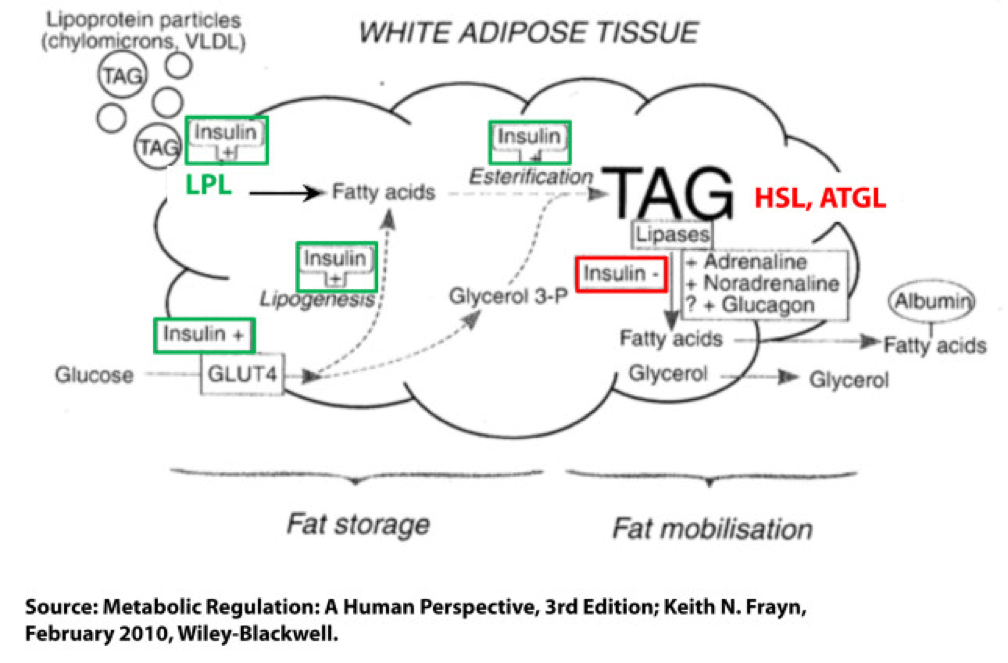

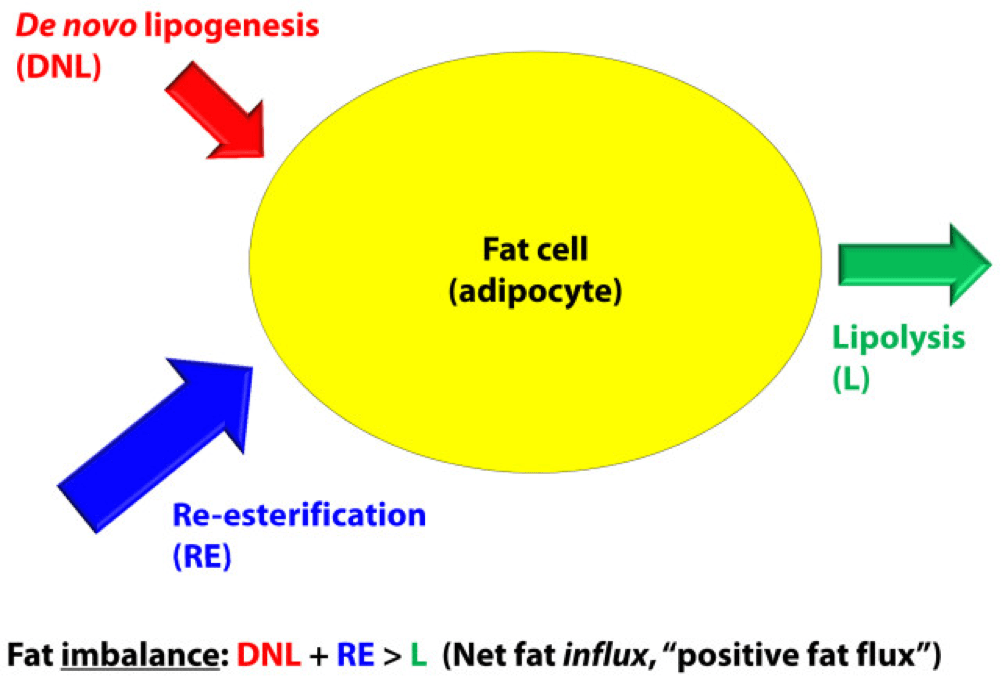
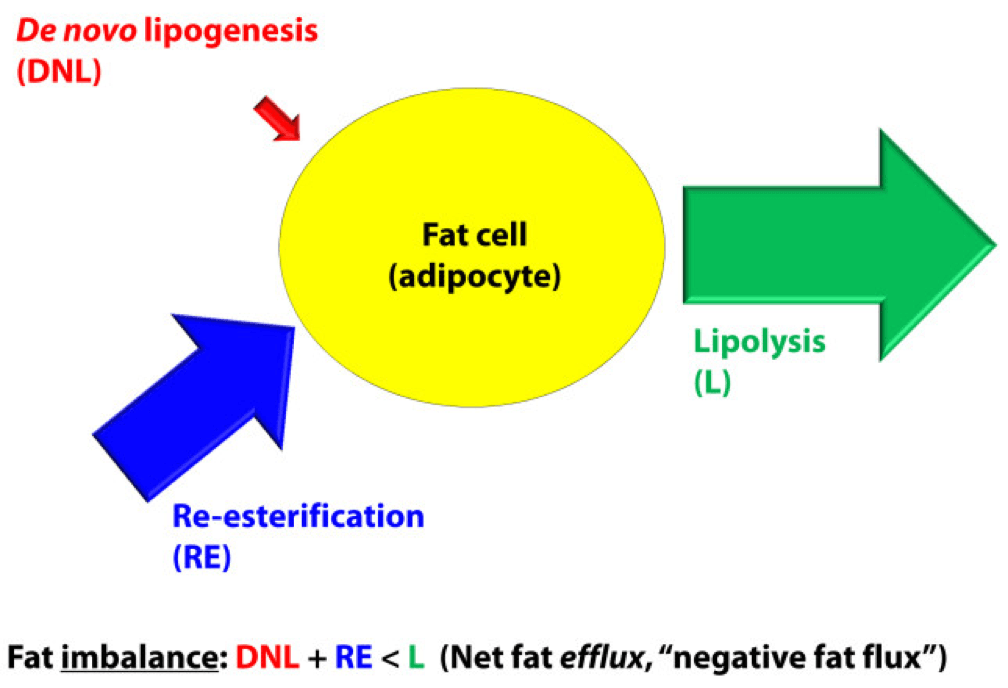
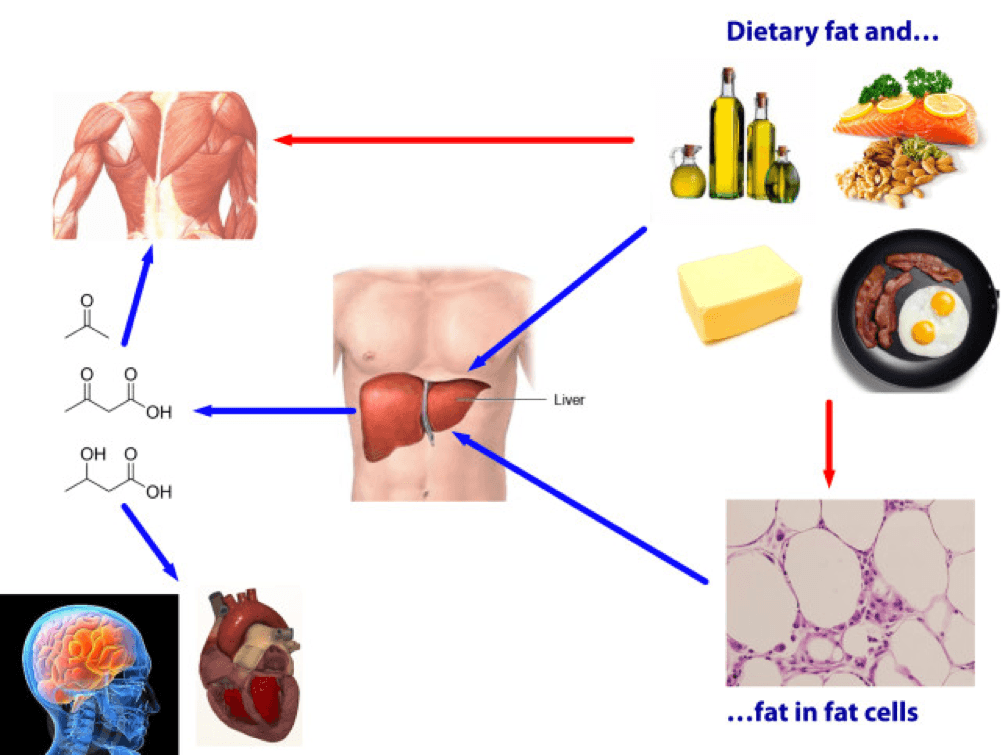
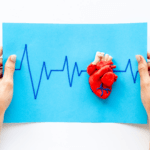
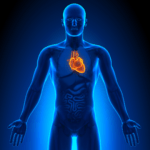
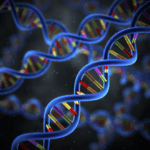
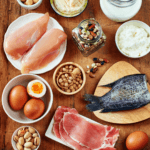
“Certainly another state of net fat efflux is starvation. DNL and RE are both very small, especially DNL, and lipolysis is quite large. This is probably the most rapid state of negative fat flux a human can experience.”
I suspect that’s where leptin research may help. With high leptin (and satiety) lipolysis should be accelerated, hence “marginal satiety” with a combination of low carbs(low insulin) might be the optimal solution.
Leptin does not appear to do much when it is high, only the reverse. In other words, low leptin is a signal to eat, but high leptin is not a signal to stop/not eat.
Apologies for having a third post. Let me offer my hobbyist research notes on it, in case it offers more. Further apologies if it offers nothing more.
“On Leptin and why Satiety matters:
Leptin itself is directly proportional to the amount of white fat and to a much lesser extend other parts of the body (brown adipose tissue, placenta (syncytiotrophoblasts), ovaries, skeletal muscle, stomach (the lower part of the fundic glands), mammary epithelial cells, bone marrow, pituitary, liver, gastric chief cells and P/D1 cells in the stomach).
Hence its base amount is mainly regulated by the amount of body fat, it won’t alter easily without conscious effort or other external means.
However, it will reduce in amount when in starvation/very-low-calorie diets [2 studies found supporting it following leptin’s wikipedia article].
Leptin is detected by a part of the brain (Hypothalamus) and – directly – does the following things:
a) In the Hypothalamus, it decreases the activity of neuropeptide Y neurons, that when active promote fat storage and hunger.
b) It decreases the activity of Agouti-related peptide that promotes hunger and reduces energy expenditure.
c) In promotes the release of ?-Melanocyte-stimulating hormone (?-MSH) which promotes Melanogenesis which among other things decreases appetite.[source for it found on wikipedia].
Hence being on very low calorie (not carb or high fat) diets can bring a decrease in leptin which in turn does bad things, conversely, satiety will keep leptin at higher levels, promoting easier fat loss and a healthier life.”
It’s mainly from following sources and links from the wikipedia article for leptin.
All I want to say is that I LOVE YOU! Keep up the good fight. We all deserve better doctors. Thank you for what you are doing.
Thank you, Olga.
1.21 GIGAWATTS!!!
That is all.
Maybe closer to 1.22…
Hi Dr. Attia,
Excellent article. The overly simplistic caloric hypothesis of obesity is indeed dead. It is only promoted by the deeply ignorant who need to see their world in simple black and white, instead of shades of grey. It is only promoted by snake oil salesmen who are unaware of contemporary obesity science and the hellish complexity of human physiology. Real scientists acknowledge uncertainty and unknowns.
There is much the caloric hypothesis cannot explain:
* For example , even successful gastric bypass patients still have a very substantial amount of body fat. Sure they are smaller in size ( which varies among individual to individual) but still obese- only less. Their body fat percentage would be surprisingly high, despite a reduced *overall mass*- mass being the key word here rather than fat tissue per se. They probably lost a lot of muscle too. To add insult to injury, this poor result is their “reward” for only eating 800 to 1,000 calories! How unfair is that? These patients are eating ONLY 1/3 of what normal to thin people eat- regular non-obese among the population. I have played basketball against “successful” patients ( some close friends, other strangers ) and their backs literally feel as soft as a pillow as they back me into the basket ( I hand check with my forearm) . This is indicative of high body fat. Basically many or most of them are left with a smaller version of their previous self, but still considerably fat. I have seen many patients first hand over the years. Their bodies are loaded with fat in every nook and cranny. Their body composition is nowhere near a person who was never obese- just regular- let alone a truly lean individual such as , say, Allen Iverson or Evander Holyfield etc.
This is not to criticize these patients at all. I applaud their efforts and sympathize with them. Rather, it is an indictment of the dogma of modern medicine. These patients are victims of the poor treatment options. That said, currently it sppears to be the best we have. But it does not work anywhere near as well as advertised as Dr. Jeffrey Friedman has noted many times publicly during his lectures.
*Another example is world class Olympic endurance athletes and swimmers ( often female) getting liposuction for stubborn body fat that is completely resistant to diet and their immense exercise regimes. Their are YouTube videos of procedures to prove this really happens. Fat does act like a tumour it seems.
Science is moving toward the regulation/dysregulation of fat cells, as well as the chemical behavior of fat cells’ receptors. This is a hypothesis “with legs.” The first law of thermodynamics is being completely abused and misused by numerous well known Blog authors who attack Gary Taubes ( and myself). I have personally confirmed this with some of the best physicists in the world. They all agree with Gary’s thermodynamics explanation to a tee . even if it is indirectly. Dr. Christopher Jarzynsky ( world renowned pioneering non- equilibrium thermodynamics scientist) personally told me by e-mail that ” the loss and gain of fat/muscle are extremely complex biochemical processes best understood within the framework of physiology. It’s NOT a matter of basic thermodynamics.” Many M.I.T. professors recommended Dr. Jarzynski to me.
I think both Gary Taubes and yourself do an excellent job of ” reasoning from evidence ” – which is what we do in science. The both of you step outside of the box and try your best to get to the bottom of it . I think you guys are doing what Richard Feynman suggested when dealing with a complicated problem- “think like a Martian.” Looking at the problem completely anew as if you never saw it before. 🙂
I wish NuSi much success. Don’t worry about the Internet “gurus” who attack Gary’s work. Just ignore them. They are all charlatans. My buddy, Urgelt of Youtube, is highly scientifically literate and intelligent. He identified numerous Bloggers as hucksters immediately. In fact, the well known and infamous Bloggers who constantly critcize Gary are almost comical in their lack of understanding of science. Having learned from Urgelt, I see this more clearly than ever. Urgelt respects Gary’s science journalism work a lot and recognizes him as a person who understands science well.
Best wishes,
Raz
Thanks for the perspective, Raz.
Interestingly, the calories hypothesis might be coming back from well, a bit unexpected direction, cf. e.g.two quotes from a short article from a well known site:
https://robbwolf.com/2013/11/07/impact-nutrition-autoimmune-disease-part-3/
“the presence of excessive nutrient intake and subsequent systemic metabolic dysfunction is not controversial”
“Evidence for the metabolic effects of immunity on the loss of tolerance suggest that over-nutrition may be a crucial component of this process, and could effect the mucosal barrier, as evidenced by the presence of dysbiosis and intestinal permeability in obese patients.”
Hi Peter,
The quote, “He was born on the finish line, so he thinks he won the race,” sounds suspiciously like something Yogi Berra would say.
Where would one find >98% caprylic acid in a consumable form? Most of it is 66% max in softgel form.
MPBio has it here: https://www.mpbio.com/product.php?pid=02100391, 99.5%, but they treat it like you would have to be insane to put it in your mouth, seeming to consider it to be a hazardous material, and want nearly $40 for 25 ml. How much would you consume and how frequently?
Thanks,
Edward
Purest form of caprylic acid is from a chemical company, such as Sigma chemicals. They sell 99%, but it’s quite costly. Not sure I see a need for this.
I was asking due to your September 1 response to spar: “To your last question, MCT, or better yet >98% pure caprylic acid can help.” As a solution to getting back into ketosis, after being in “no man’s land.” Thanks.
How can one get rid of gynachomastia when hormones which usually cause it come out as normal and weight loss does not make much of a difference? Any info/links would be appreciated. Thanks
Start with a check of estradiol (E2).
Peter, it came as 111pmol/L (40-162), which is apparently normal so are testosterone and prolactin.
That’s about 30 pg/mL, so, yes, pretty normal. Maybe look at E1 and E3, though unlikely.
Will do peter, many thanks
Merry Christmas Peter! God bless you and your family!
Thank you so much for all of your super-human efforts on our behalf…I know the blog is the last on your list; but, somehow you manage your monthly post. Even if in the future you just did a post without the comments, I would be so grateful. I know you can’t do this forever.
Thank you for all you teach us!
Blessings,
Maryann
Thanks so much for understanding, Maryann. I’m happy to keep up what I can.
Peter,
I really enjoyed your TED talk and love reading all the detail on your blog. I have been on a ketogenic diet for the past month and it seems to be working. Prior to my diet, my blood metrics revealed slightly high uric acid levels. What kind of risk (if any) is there by consuming more fat? I am hoping that this diet will actually reduce the uric acid levels. Also, I have OSA (obstructive sleep apnea) and am using a BiPAP machine at night. Will CPAP/BiPAP have any negative affect on weight/fat loss?
Thanks,
Robert
In my experience, there are several flaws in the low-fat processed diet that many of us have accepted.
I have discovered from my own experience and from helping clients, that people lose weight not by restricting fat as much as eating healthy fats such as nuts, oils, avocados, and wild-caught salmon, and reducing/eliminating refined starchy carbs, which the body processes as glucose. For most people, the sugar control diet helps them lose weight and establish healthy eating habits for life.
https://www.nourishingfoundations.com/do-you-want-to-manage-your-weight-in-2014/
Every time I reread a slew of your posts, I glean new insights – I cannot thank you enough.
Looking at your equation……..B-OHB (measured in blood) = B-OHB produced (from dietary fat) plus B-OHB produced (from lipolysis of TAG) less B-OHB consumed by working muscles, heart, brain.
I read this post (again) on the heels of Ketosis I and II, , as well as IFIK. Can you envision a scenario where someone is in nutritional ketosis, is in hour 15 of Martin Berkhan style(leangains) 16 hour fast, about to start the 8 hour eating window, and you check their insulin/bs/ketones – where BS would be relatively high for this fasted state (say 5.5), insulin is incredibly low (fat floodgates are wide open), and ketones are only 0.2 – in other words, fat efflux is occurring, the glycerol backbone is being used to make glucose and most of the available ketones are fueling basic cellular metabolism so the ketone level is low? Does this make metabolic sense?
It’s possible, especially if metabolic demand during the fasted period is very low, and as a result the liver is making very little BHB.
RE – IFIK – If you don’t mind my asking, did you check your B-OHB when you were feeling hungry on fast days, pre-exercise? If you have that result, would it be fair to say you would have been doing sedentary computer type activity?
This may not be the right place to ask, but I haven’t found any info on what might be a maximum dosage of coconut oil / MCTs. Can you tell me or point me in the direction to look for the info? What are the dangers of exceeding 6 tablespoons of coconut oil per day? I usually use ~4 tablespoons in my morning coffee and maybe 2 more in a cup of hot tea later in the day. I’m 58 YO T2 eating a ketogenic diet for nearly 2 years and use coconut oil to help meet my fat needs. I put in a little over 3000 miles on bicycle last year, was pretty sedentary before that. Am looking toward maybe doubling that this year and was wondering about increasing coconut oil a little. Is there any benefit of the timing of coconut oil intake?
Insulin – Ketosis – Weight Gain
Insulin will be produced by the body regardless of any and all diets – you can’t stop this – even in Ketosis – some people will gain weight according to their calorie load
For Such People the only anwser is to Control Hunger and there-by reduce Calorie Load
Controling Hunger is best and is probally the only way accomplished – by reducing Fat Intake
Overly Obese Women and many men pay should pay attention to the above sentence – most women have an RMR(resting metabolic rate) around 1500 calories – many of these women eat that much and more and wonder why there not losing weight – even in or around Ketocic levels – and Insulin production is probably the reason
Protein should be used to control hunger whether the amount results in Ketosis or not – ( – 80 to 200 grams) – animal fats should be reduced to something like 1/2 pat butter – 1/4 slice cream cheese – 2
tablespoons sour cream – 2 tablespoons raw milk and some low carb yogurt (4 carbs per serving – Kroger Brand) and eating raw nuts(almonds-peanuts -sunflower seeds – many of the calories in the raw nuts will not be absorbed becuase the body can’t break them down – but all the dairy fat and meat fat calories will be absorbed
The main reason for reducing fat is to control hunger and secondly to reduce the chances of the body storing this fat
Ketosis or Low Carb by it-self simply will not work for many people – they will store ingested fat even in these conditions – Protein to satiety – low carbs – and lowered fat intake – and reduced calories below RMR is a reasonable solution
Salt intake
Even at levels just above Ketocic may require more salt – 4 or 5 teaspoons sea salt in an empty green olive bottle with mostly water but some vinegar and black pepper added is one way of getting it
I personaly have to add 2 to 5 teaspoons sea salt daily to my diet ot eliminate cramping and I’m just above being in Ketosis generally
Not a well written comment – (mine – this) – but I have other things to do besides think up literary gems
Hi Peter, thanks for your detailed explanations. Here’s a related question. I’ve been a heavy carb user for a long time and have some symptoms of metabolic syndrome. I’ve changed to a low carb diet and 3 weeks in feel cleaner, smoother energy, more alert and am losing weight and waist inches. So far so great.
I do long distance walking, typically 30+ mile routes. I would say this is mostly aerobic with some more anaerobic parts in places (steep climbs in mud, for example). So I need to train my body to start burning fat as much as possible for this activity. But after years of abuse it’s primed to burn glycogen as soon as the going gets even slightly tough.
So how do I teach it as efficiently/quickly as possible to get better and better at upregulating fax oxidation? What can I do to really help drive that process now that I’m in a low carb low insulin state? And do I need to keep doing it or will staying low carb ensure it stays learned?
Thanks again
Chris
It takes time, but RQ will migrate to match FQ, and that’s the biggest step. Sounds like you’re on the right course.
Thanks Peter, sorry but I cannot find what FQ means on your blog. The only reference to it is here. Do these stand for Respitory Quotient (fat vs glycogen use) and Fat Quotient (ie simply how much fat vs how much carb in your diet?
If so you are saying that eating more fat, not necessarily doing more aerobic exercise, is what upregulates fat oxidation pathways more than anything? This seems counterintuitive to me. Sorry if I’ve misunderstood you.
It’s the “RQ” of your diet if you burned the food. The more fat in the diet, the closer to 0.7, the more CHO, the closer to 1.0
Hi Peter,
I half-accidently stumbled upon your blog, and your analytic approach has given me the long awaited inspiration to try low carb diet for losing weight. Thanks for that!
May I ask if you have personal experience or know of reliable reseaech of any side effects of low carb diet (not a diabetic, not doing extreme intensity sports) E.g. how would you comment this https://news.bbc.co.uk/2/hi/health/4435046.stm Would you agree they have a relevant point to consider?
Thanks in advance!
Great article by the way! It’s nice to see someone “show their work” instead of just make statements. 🙂
What I take away from this is (but maybe I am misinterpreting)…
1. Fat really is the bad guy (fat makes you fat) IF it is in the presence of insulin since DLN is always relatively much lower than RE.
2. Fat is the good guy if not in the presence of CHO/insulin.
3. Hormone level differences among people have a big effect on what diet someone should follow.